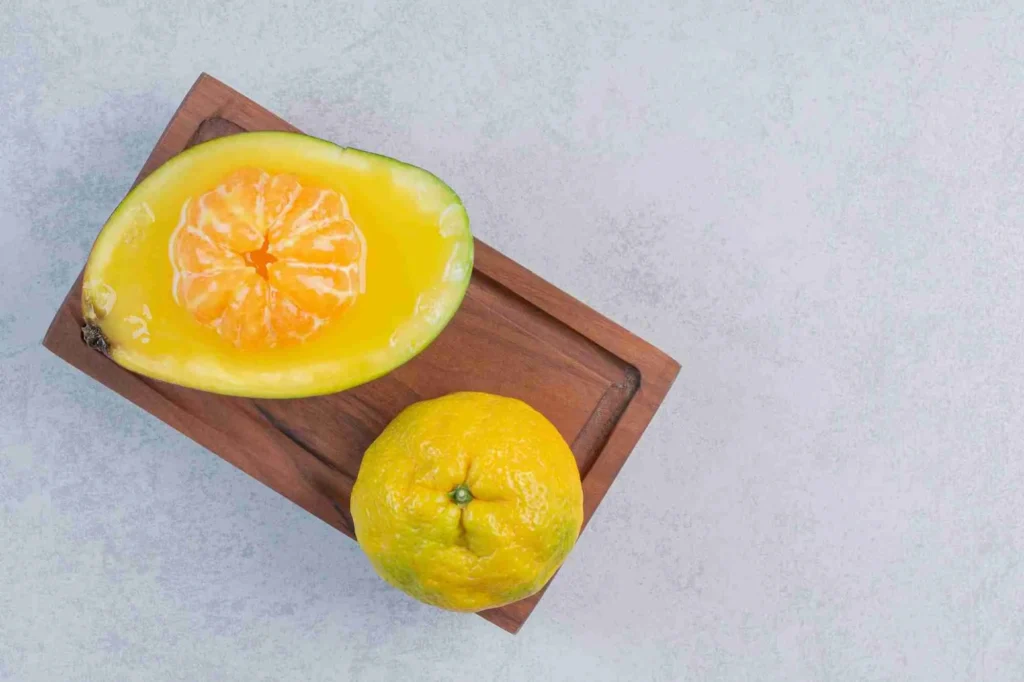If you’ve ventured into the world of dining lately, you might have encountered the name yuzu on a menu. This unique citrus fruit has become a favorite for chefs, bakers, and mixologists, who know exactly how to use its bold flavor to add that je ne sais quoi factor to their dishes. It’s no wonder this fruit is loved for its bright, zesty tastes-like blend of lemon and grapefruit. While seasoned food professionals may have long mastered the know-how of using yuzu, fortunately, you don’t have to be an expert to try it yourself.
Here’s a tip: source fresh or bottled yuzu and cook up something amazing! It’s not just about the flavor—it has potential health benefits, too. So, whether you’re eager to bring a twist to your next recipe or explore its role in modern cuisine, yuzu is everything you need to know about lately.
What Is Yuzu Fruit?
Yuzu is a fragrant, sour citrus fruit that originates in China and Korea, though it is most famously associated with the food of Japan. This Japanese citron, called yuja in Korean, is a mix of the Ichang papeda and a sour mandarin orange. Resembling a small tangerine, it has a thick, bumpy rind that starts off green and turns warm yellow when fully ripe.
Inside, the flesh is filled with many seeds, making it yield less juice than a lemon or lime. Due to its difficult harvest, this unique variety is often more expensive compared to other citrus varieties, but its complex flavor is well worth it for culinary enthusiasts.
What Does Yuzu Taste Like?
Yuzu fruit is a unique citrus fruit with a distinct flavor profile that’s hard to forget. It brings a bold, tart kick that’s both sour and tangy, reminiscent of a mix between lemon, bitter grapefruit, and sweet orange. Its aroma is remarkably powerful, often giving off a zesty and honeysuckle-like fragrance when fully ripe.
What sets yuzu apart are the subtle floral and herbal notes that underscored its unique character, making it different when compared to other common citrus varieties. These delightful hints of complexity make yuzu a favorite in kitchens for sauces, marinades, and desserts.

The Cultural Significance of Yuzu
In both Japanese and Korean cooking, the unique fruit known as yuzu holds a special place. However, its significance shines brighter in Japan, where this fragrant citrus is deeply intertwined with the cuisine. Whether enhancing the flavors of soup, complementing sashimi, or adding zest to pastries, yuzu plays a versatile role.
It also has a symbolic presence in seasonal celebrations, especially during the winter solstice, when taking a yuzu bath is believed to bring good luck. The island of Shikoku, home to one of the largest producers of yuzu, embraces the fruit as both a celebrated commodity and an emblem of its culture. Across its prefectures, a dedicated festival every fall honors this cherished fruit, showcasing its importance in the region’s traditions and daily life.
How Is Yuzu Typically Used?
Yuzu is a distinctive and adaptable fruit that offers a blast of flavor and perfume to the kitchen. Often compared to lemons and limes, it offers a more intense taste with a tart and floral profile. Its juice adds an acid kick and depth to any dish, while the zest contributes a vibrant zing and fragrance. Try incorporating it into a vinaigrette, marinade, or cocktail to elevate your meals, or use it to enhance a dessert.
If you’re working with a recipe for a salad dressing or a lemony dinner, consider yuzu as a substitute. Keep the ratio in mind—start small and adjust to your taste. The entire fruit can also be preserved in sugar, creating a delightful marmalade or compote perfect for pairing with tea, as seen in yuja-cha from Korea. While yuzu is rarely eaten straight, its potential in the kitchen is immense.
Unlike other lemons and limes, yuzu is versatile throughout all stages of maturity. Whether ripe and juicy or unripe and green, it delivers distinct uses. For example, the rock-hard zest of unripe yuzu can be a perfect garnish or flavoring agent. In Japan, this zest often shines in kosho, a spicy, fermented paste made with chiles and salt.
Beyond the kitchen, yuzu is a popular ingredient in aromatherapy and skin-care products, celebrated for its calming effect and high concentration of vitamin C, making it a favorite in anti-aging regimes. With its incredible adaptability and unmatched flavor, yuzu is a must-try for culinary and wellness enthusiasts alike.
Health Boosting Powers of Yuzu
Yuzu is not just celebrated for its unique culinary uses, but it’s also a treasure trove of nutrients that support the body and enhance overall well-being. Packed with vitamins, minerals, and fiber, this citrus fruit has a robust nutritional profile that makes it a powerful source of essential nutrients.
What stands out most is its high concentration of vitamin C, delivering a whopping 59% of the Daily Value in just a 3.5-ounce serving of its fresh juice. Beyond this, antioxidants like flavonoids and carotenoids help combat inflammation and neutralize damage caused by free radicals, making yuzu an excellent choice for those prioritizing their health.
What makes yuzu even more intriguing is its lesser-known use in aromatherapy. In limited studies, subjects reported experiencing positive benefits such as increased energy and productivity while feeling decreased fatigue, tension, and anxiety.
The practice of practicing aromatherapy with yuzu’s refreshing scent isn’t just soothing—it’s revitalizing, helping people unlock their potential in both mental and physical ways. Its dual role as a nutrient-dense fruit and an energizing scent proves why yuzu deserves a place in both your kitchen and wellness routine.
Adding Yuzu to Your Culinary Adventures
Yuzu, a citrus fruit, adds an aromatic and flavorful twist to dishes. Its tangy juice and zesty rind pack a punch of vitamin C, much like a lemon or lime, but with a distinct character. Though it has many seeds, it’s surprisingly easy to use. A splash of yuzu can make your dish shine, enhancing its brightness and delighting your palate.
Also, visit Nutri Balance Quest for more information

